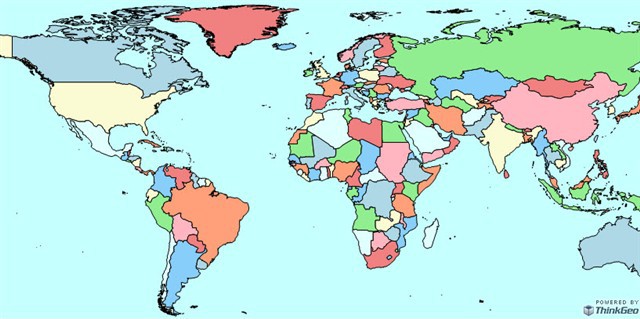To further illustrate what Sun explained to you using ValueStyle, you can see how you can apply this Style to a polygon based layer as it is your case to the countries02.shp shapefile that comes with the sample data. Here, you take the column "COLOR_MAP" and assign a different color for each value from 1 to 8. The result is a map with all the countries being pleasantly displayed and well distinguished. This is another way on how ValueStyle can be useful to apply to your data.

ShapeFileFeatureLayer CountriesLayer = new ShapeFileFeatureLayer(@"..\..\Data\countries02.shp");
// Draw features based on values
ValueStyle valueStyle = new ValueStyle();
valueStyle.ColumnName = "COLOR_MAP";
valueStyle.ValueItems.Add(new ValueItem("1", AreaStyles.CreateSimpleAreaStyle(GeoColor.StandardColors.LightGreen,GeoColor.StandardColors.Black)));
valueStyle.ValueItems.Add(new ValueItem("2", AreaStyles.CreateSimpleAreaStyle(GeoColor.StandardColors.LightPink, GeoColor.StandardColors.Black)));
valueStyle.ValueItems.Add(new ValueItem("3", AreaStyles.CreateSimpleAreaStyle(GeoColor.StandardColors.LightCyan, GeoColor.StandardColors.Black)));
valueStyle.ValueItems.Add(new ValueItem("4", AreaStyles.CreateSimpleAreaStyle(GeoColor.StandardColors.LightBlue, GeoColor.StandardColors.Black)));
valueStyle.ValueItems.Add(new ValueItem("5", AreaStyles.CreateSimpleAreaStyle(GeoColor.StandardColors.LightGoldenrodYellow, GeoColor.StandardColors.Black)));
valueStyle.ValueItems.Add(new ValueItem("6", AreaStyles.CreateSimpleAreaStyle(GeoColor.StandardColors.LightSalmon, GeoColor.StandardColors.Black)));
valueStyle.ValueItems.Add(new ValueItem("7", AreaStyles.CreateSimpleAreaStyle(GeoColor.StandardColors.LightCoral, GeoColor.StandardColors.Black)));
valueStyle.ValueItems.Add(new ValueItem("8", AreaStyles.CreateSimpleAreaStyle(GeoColor.StandardColors.LightSkyBlue, GeoColor.StandardColors.Black)));
CountriesLayer.ZoomLevelSet.ZoomLevel01.CustomStyles.Add(valueStyle);
CountriesLayer.ZoomLevelSet.ZoomLevel01.ApplyUntilZoomLevel = ApplyUntilZoomLevel.Level20;

